Analysis of Operations Management Principles at Mango: A Report
VerifiedAdded on 2023/06/08
|17
|4730
|120
Report
AI Summary
This report provides a comprehensive analysis of Mango's operations management, differentiating between operation and operations management. It reviews the implementation of operations management principles within the organization, focusing on lean and agile manufacturing. The report evaluates the extent to which Mango's operations meet organizational requirements, emphasizing quality and cost-effectiveness. It discusses continuous improvement as a philosophy, detailing lean principles and their application within Mango. Furthermore, the report proposes a continuous improvement plan with justified recommendations, addressing waste reduction, and process optimization. The analysis highlights Mango's strategies for efficiency, customer satisfaction, and sustainable practices, offering insights into its operational success and areas for enhancement. The report concludes with a summary of the key findings and recommendations for further improvement.

OPERATIONAL
MANAGMENT
0
MANAGMENT
0
Paraphrase This Document
Need a fresh take? Get an instant paraphrase of this document with our AI Paraphraser
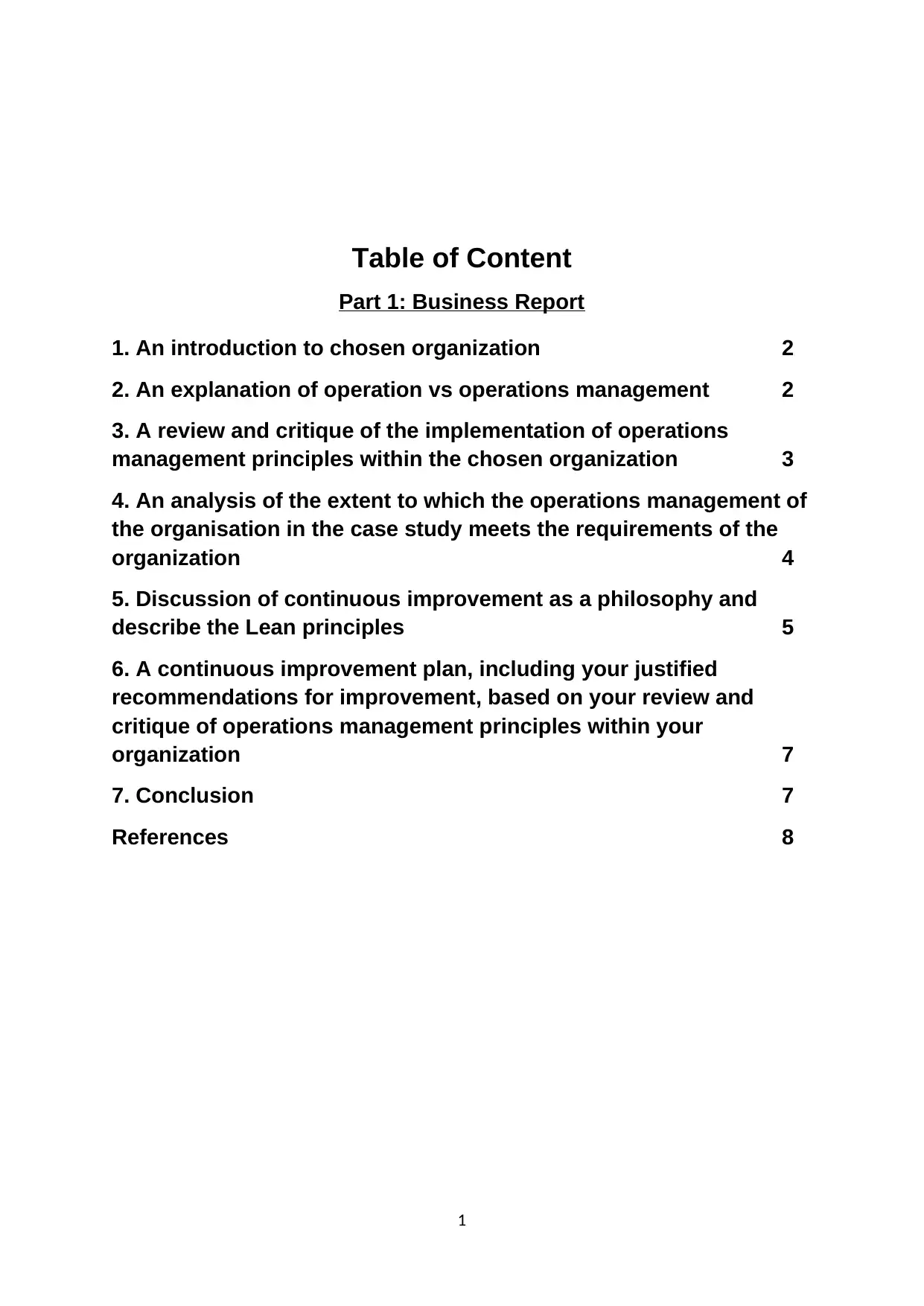
Table of Content
Part 1: Business Report
1. An introduction to chosen organization 2
2. An explanation of operation vs operations management 2
3. A review and critique of the implementation of operations
management principles within the chosen organization 3
4. An analysis of the extent to which the operations management of
the organisation in the case study meets the requirements of the
organization 4
5. Discussion of continuous improvement as a philosophy and
describe the Lean principles 5
6. A continuous improvement plan, including your justified
recommendations for improvement, based on your review and
critique of operations management principles within your
organization 7
7. Conclusion 7
References 8
1
Part 1: Business Report
1. An introduction to chosen organization 2
2. An explanation of operation vs operations management 2
3. A review and critique of the implementation of operations
management principles within the chosen organization 3
4. An analysis of the extent to which the operations management of
the organisation in the case study meets the requirements of the
organization 4
5. Discussion of continuous improvement as a philosophy and
describe the Lean principles 5
6. A continuous improvement plan, including your justified
recommendations for improvement, based on your review and
critique of operations management principles within your
organization 7
7. Conclusion 7
References 8
1

1. An introduction to chosen organization
Operations management refers to the management of business processes and
activities for maximizing the effectiveness and efficiency within a firm. In order to
balance revenues and expenditures and generate the best operational profit feasible,
it entails planning, coordinating, and managing the organization's processes. Teams
in charge of operations management strive to produce the maximum net operational
profit by balancing expenses and revenues. In this report, the mentioned
organization is Mango which is an international brand, offering a wide variety of
apparels, footwear and accessories for every generation (Mitic, 2022). Mango is
founded by Isac Andic and Nahman Andic in 1984 in Barcelona, Spain. The report
tells the difference between operation and management of operation and review the
implementation of the principles of the operations management in the organization
‘Mango’. It also elaborates the need of continuous improvement in the ‘Mango’ with
the help of lean principles and use key measures to improve the performance of the
firm with their improvement plans.
2. An explanation of operation vs operations
management
Difference between operation and operational management-
Operation Operational Management
Managing your company's
internal processes to ensure
maximum efficiency is known as
operations. Every small business
owner must supervise the
planning and administration of
behind-the-scenes labor,
regardless of whether you
manufacture items, sell products,
or offer services (Kuruppuge and
Gregar, 2020).
Type of industry and the stage of
the firm helps in defining the
related operations. Improvement
Managing a company's
operations to guarantee project
execution efficiency is the focus
of the business discipline known
as operations management. It
implies that the department head
would be expected to carry out a
number of strategic tasks,
including product design,
forecasting, supply chain
management, delivery
management, etc.
Operations management is a
cross-departmental position
2
Operations management refers to the management of business processes and
activities for maximizing the effectiveness and efficiency within a firm. In order to
balance revenues and expenditures and generate the best operational profit feasible,
it entails planning, coordinating, and managing the organization's processes. Teams
in charge of operations management strive to produce the maximum net operational
profit by balancing expenses and revenues. In this report, the mentioned
organization is Mango which is an international brand, offering a wide variety of
apparels, footwear and accessories for every generation (Mitic, 2022). Mango is
founded by Isac Andic and Nahman Andic in 1984 in Barcelona, Spain. The report
tells the difference between operation and management of operation and review the
implementation of the principles of the operations management in the organization
‘Mango’. It also elaborates the need of continuous improvement in the ‘Mango’ with
the help of lean principles and use key measures to improve the performance of the
firm with their improvement plans.
2. An explanation of operation vs operations
management
Difference between operation and operational management-
Operation Operational Management
Managing your company's
internal processes to ensure
maximum efficiency is known as
operations. Every small business
owner must supervise the
planning and administration of
behind-the-scenes labor,
regardless of whether you
manufacture items, sell products,
or offer services (Kuruppuge and
Gregar, 2020).
Type of industry and the stage of
the firm helps in defining the
related operations. Improvement
Managing a company's
operations to guarantee project
execution efficiency is the focus
of the business discipline known
as operations management. It
implies that the department head
would be expected to carry out a
number of strategic tasks,
including product design,
forecasting, supply chain
management, delivery
management, etc.
Operations management is a
cross-departmental position
2
⊘ This is a preview!⊘
Do you want full access?
Subscribe today to unlock all pages.

Trusted by 1+ million students worldwide

in operations assist the system
and processes of a business
strategically. And in other ways, it
helps in bringing every feature of
a project from small to large and
do corrections in it.
To understand the impact of
working and processes of a small
business in day-to-day tasks,
both employees and owner
needs to be attentive. There are
some examples of operations in
different industry are given below
which shows how stimulating the
processes can contribute in
achieving goals:
For a retail business
For a restaurant
For a service company
For a manufacturing company
For a digital company
where the manager takes on a
variety of duties across many
disciplines, in contrast to
marketing or finance
departments where managers
are accountable for their
departments.
By continuously assessing the
money spent on creating the final
products, operational
management aids in cost
containment (Jackson and
Adamson, 2018). In terms of
manufacturing, productions, or
the delivery of services, it is
primarily concerned with
overseeing, coordinating, and
planning.
3. A review and critique of the implementation of
operations management principles within the chosen
organization
An environment management system is essentially created with the intention
of ensuring that the company's environmental goals and targets can be met in
accordance with its environmental regulations. In order to achieve business
objectives as effectively as possible, operations management is important (Nikouei
and Mardani, 2021). The suggested business process concentrates on a continuous
process of improvement actions to obtain the results much better ways, including
quicker delivery, equipment utilization, improved workforce, and higher-quality items.
Mango's growth plan involves vertical integration and diversification.
Lean Production:
The goal of the management strategy known as lean production is to eliminate waste
while maintaining quality. This method may be used across all areas of a firm,
including design, manufacturing, and distribution. By increasing a company's
productivity and responsiveness to customer requirements, lean manufacturing
3
and processes of a business
strategically. And in other ways, it
helps in bringing every feature of
a project from small to large and
do corrections in it.
To understand the impact of
working and processes of a small
business in day-to-day tasks,
both employees and owner
needs to be attentive. There are
some examples of operations in
different industry are given below
which shows how stimulating the
processes can contribute in
achieving goals:
For a retail business
For a restaurant
For a service company
For a manufacturing company
For a digital company
where the manager takes on a
variety of duties across many
disciplines, in contrast to
marketing or finance
departments where managers
are accountable for their
departments.
By continuously assessing the
money spent on creating the final
products, operational
management aids in cost
containment (Jackson and
Adamson, 2018). In terms of
manufacturing, productions, or
the delivery of services, it is
primarily concerned with
overseeing, coordinating, and
planning.
3. A review and critique of the implementation of
operations management principles within the chosen
organization
An environment management system is essentially created with the intention
of ensuring that the company's environmental goals and targets can be met in
accordance with its environmental regulations. In order to achieve business
objectives as effectively as possible, operations management is important (Nikouei
and Mardani, 2021). The suggested business process concentrates on a continuous
process of improvement actions to obtain the results much better ways, including
quicker delivery, equipment utilization, improved workforce, and higher-quality items.
Mango's growth plan involves vertical integration and diversification.
Lean Production:
The goal of the management strategy known as lean production is to eliminate waste
while maintaining quality. This method may be used across all areas of a firm,
including design, manufacturing, and distribution. By increasing a company's
productivity and responsiveness to customer requirements, lean manufacturing
3
Paraphrase This Document
Need a fresh take? Get an instant paraphrase of this document with our AI Paraphraser
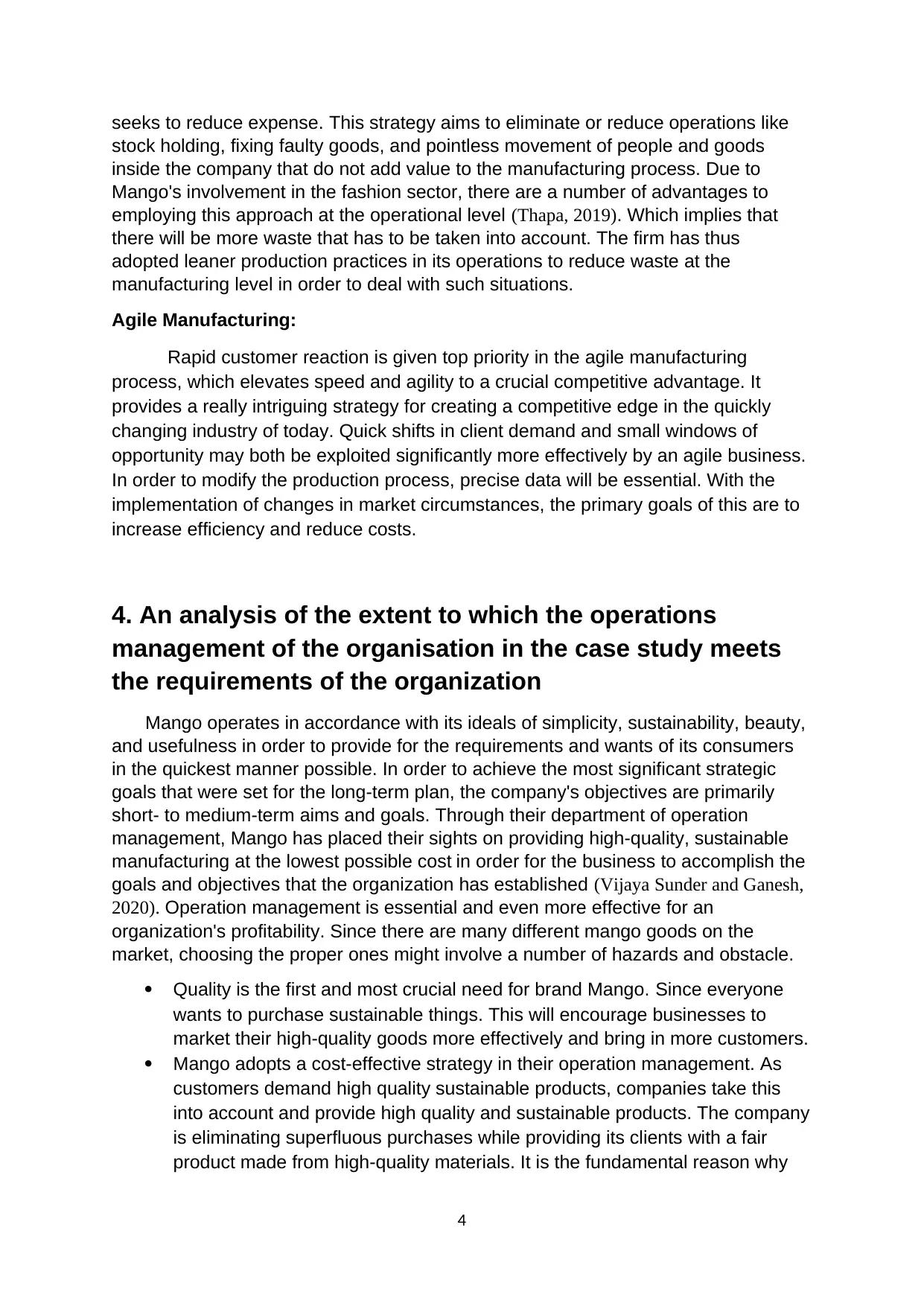
seeks to reduce expense. This strategy aims to eliminate or reduce operations like
stock holding, fixing faulty goods, and pointless movement of people and goods
inside the company that do not add value to the manufacturing process. Due to
Mango's involvement in the fashion sector, there are a number of advantages to
employing this approach at the operational level (Thapa, 2019). Which implies that
there will be more waste that has to be taken into account. The firm has thus
adopted leaner production practices in its operations to reduce waste at the
manufacturing level in order to deal with such situations.
Agile Manufacturing:
Rapid customer reaction is given top priority in the agile manufacturing
process, which elevates speed and agility to a crucial competitive advantage. It
provides a really intriguing strategy for creating a competitive edge in the quickly
changing industry of today. Quick shifts in client demand and small windows of
opportunity may both be exploited significantly more effectively by an agile business.
In order to modify the production process, precise data will be essential. With the
implementation of changes in market circumstances, the primary goals of this are to
increase efficiency and reduce costs.
4. An analysis of the extent to which the operations
management of the organisation in the case study meets
the requirements of the organization
Mango operates in accordance with its ideals of simplicity, sustainability, beauty,
and usefulness in order to provide for the requirements and wants of its consumers
in the quickest manner possible. In order to achieve the most significant strategic
goals that were set for the long-term plan, the company's objectives are primarily
short- to medium-term aims and goals. Through their department of operation
management, Mango has placed their sights on providing high-quality, sustainable
manufacturing at the lowest possible cost in order for the business to accomplish the
goals and objectives that the organization has established (Vijaya Sunder and Ganesh,
2020). Operation management is essential and even more effective for an
organization's profitability. Since there are many different mango goods on the
market, choosing the proper ones might involve a number of hazards and obstacle.
Quality is the first and most crucial need for brand Mango. Since everyone
wants to purchase sustainable things. This will encourage businesses to
market their high-quality goods more effectively and bring in more customers.
Mango adopts a cost-effective strategy in their operation management. As
customers demand high quality sustainable products, companies take this
into account and provide high quality and sustainable products. The company
is eliminating superfluous purchases while providing its clients with a fair
product made from high-quality materials. It is the fundamental reason why
4
stock holding, fixing faulty goods, and pointless movement of people and goods
inside the company that do not add value to the manufacturing process. Due to
Mango's involvement in the fashion sector, there are a number of advantages to
employing this approach at the operational level (Thapa, 2019). Which implies that
there will be more waste that has to be taken into account. The firm has thus
adopted leaner production practices in its operations to reduce waste at the
manufacturing level in order to deal with such situations.
Agile Manufacturing:
Rapid customer reaction is given top priority in the agile manufacturing
process, which elevates speed and agility to a crucial competitive advantage. It
provides a really intriguing strategy for creating a competitive edge in the quickly
changing industry of today. Quick shifts in client demand and small windows of
opportunity may both be exploited significantly more effectively by an agile business.
In order to modify the production process, precise data will be essential. With the
implementation of changes in market circumstances, the primary goals of this are to
increase efficiency and reduce costs.
4. An analysis of the extent to which the operations
management of the organisation in the case study meets
the requirements of the organization
Mango operates in accordance with its ideals of simplicity, sustainability, beauty,
and usefulness in order to provide for the requirements and wants of its consumers
in the quickest manner possible. In order to achieve the most significant strategic
goals that were set for the long-term plan, the company's objectives are primarily
short- to medium-term aims and goals. Through their department of operation
management, Mango has placed their sights on providing high-quality, sustainable
manufacturing at the lowest possible cost in order for the business to accomplish the
goals and objectives that the organization has established (Vijaya Sunder and Ganesh,
2020). Operation management is essential and even more effective for an
organization's profitability. Since there are many different mango goods on the
market, choosing the proper ones might involve a number of hazards and obstacle.
Quality is the first and most crucial need for brand Mango. Since everyone
wants to purchase sustainable things. This will encourage businesses to
market their high-quality goods more effectively and bring in more customers.
Mango adopts a cost-effective strategy in their operation management. As
customers demand high quality sustainable products, companies take this
into account and provide high quality and sustainable products. The company
is eliminating superfluous purchases while providing its clients with a fair
product made from high-quality materials. It is the fundamental reason why
4
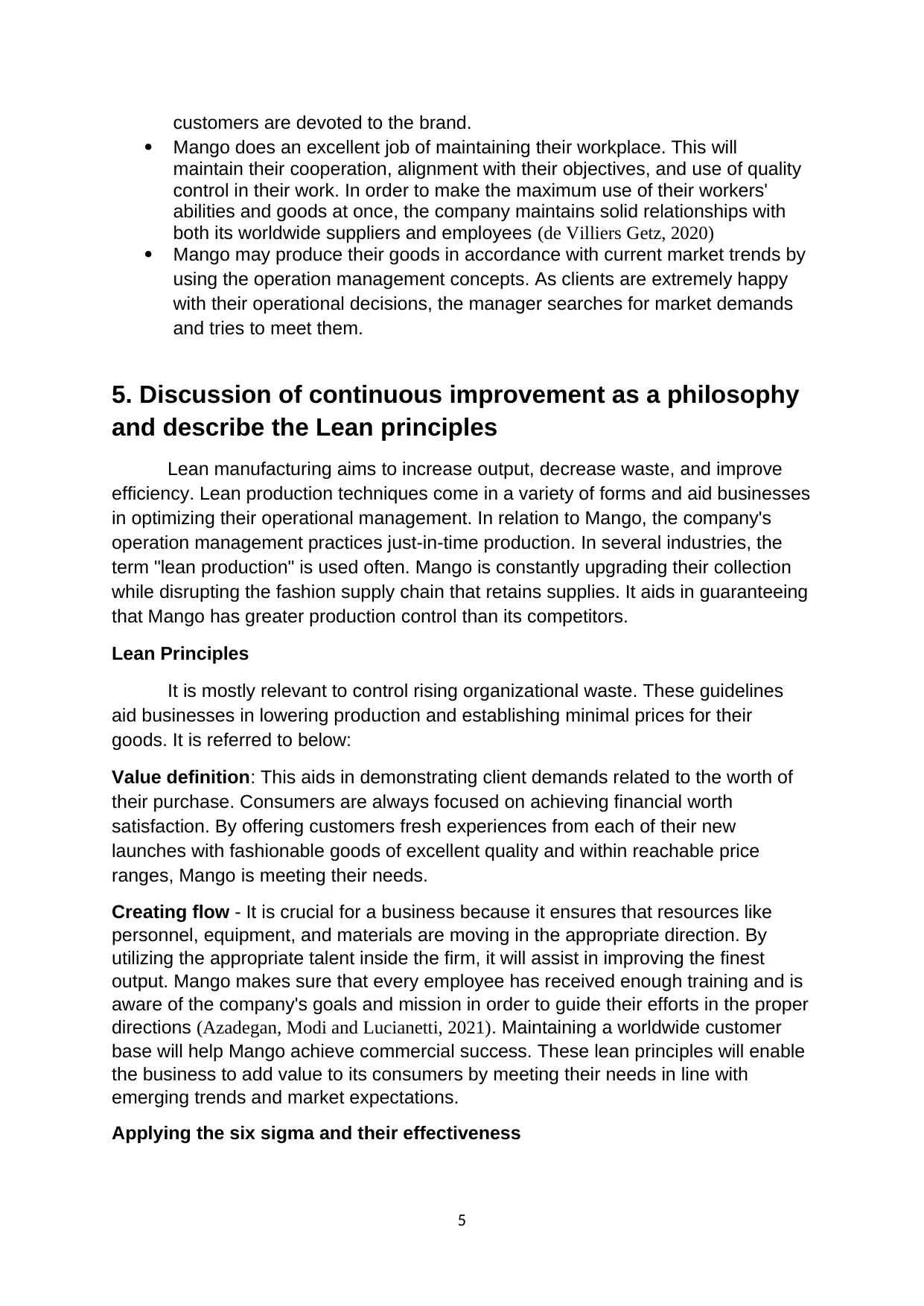
customers are devoted to the brand.
Mango does an excellent job of maintaining their workplace. This will
maintain their cooperation, alignment with their objectives, and use of quality
control in their work. In order to make the maximum use of their workers'
abilities and goods at once, the company maintains solid relationships with
both its worldwide suppliers and employees (de Villiers Getz, 2020)
Mango may produce their goods in accordance with current market trends by
using the operation management concepts. As clients are extremely happy
with their operational decisions, the manager searches for market demands
and tries to meet them.
5. Discussion of continuous improvement as a philosophy
and describe the Lean principles
Lean manufacturing aims to increase output, decrease waste, and improve
efficiency. Lean production techniques come in a variety of forms and aid businesses
in optimizing their operational management. In relation to Mango, the company's
operation management practices just-in-time production. In several industries, the
term "lean production" is used often. Mango is constantly upgrading their collection
while disrupting the fashion supply chain that retains supplies. It aids in guaranteeing
that Mango has greater production control than its competitors.
Lean Principles
It is mostly relevant to control rising organizational waste. These guidelines
aid businesses in lowering production and establishing minimal prices for their
goods. It is referred to below:
Value definition: This aids in demonstrating client demands related to the worth of
their purchase. Consumers are always focused on achieving financial worth
satisfaction. By offering customers fresh experiences from each of their new
launches with fashionable goods of excellent quality and within reachable price
ranges, Mango is meeting their needs.
Creating flow - It is crucial for a business because it ensures that resources like
personnel, equipment, and materials are moving in the appropriate direction. By
utilizing the appropriate talent inside the firm, it will assist in improving the finest
output. Mango makes sure that every employee has received enough training and is
aware of the company's goals and mission in order to guide their efforts in the proper
directions (Azadegan, Modi and Lucianetti, 2021). Maintaining a worldwide customer
base will help Mango achieve commercial success. These lean principles will enable
the business to add value to its consumers by meeting their needs in line with
emerging trends and market expectations.
Applying the six sigma and their effectiveness
5
Mango does an excellent job of maintaining their workplace. This will
maintain their cooperation, alignment with their objectives, and use of quality
control in their work. In order to make the maximum use of their workers'
abilities and goods at once, the company maintains solid relationships with
both its worldwide suppliers and employees (de Villiers Getz, 2020)
Mango may produce their goods in accordance with current market trends by
using the operation management concepts. As clients are extremely happy
with their operational decisions, the manager searches for market demands
and tries to meet them.
5. Discussion of continuous improvement as a philosophy
and describe the Lean principles
Lean manufacturing aims to increase output, decrease waste, and improve
efficiency. Lean production techniques come in a variety of forms and aid businesses
in optimizing their operational management. In relation to Mango, the company's
operation management practices just-in-time production. In several industries, the
term "lean production" is used often. Mango is constantly upgrading their collection
while disrupting the fashion supply chain that retains supplies. It aids in guaranteeing
that Mango has greater production control than its competitors.
Lean Principles
It is mostly relevant to control rising organizational waste. These guidelines
aid businesses in lowering production and establishing minimal prices for their
goods. It is referred to below:
Value definition: This aids in demonstrating client demands related to the worth of
their purchase. Consumers are always focused on achieving financial worth
satisfaction. By offering customers fresh experiences from each of their new
launches with fashionable goods of excellent quality and within reachable price
ranges, Mango is meeting their needs.
Creating flow - It is crucial for a business because it ensures that resources like
personnel, equipment, and materials are moving in the appropriate direction. By
utilizing the appropriate talent inside the firm, it will assist in improving the finest
output. Mango makes sure that every employee has received enough training and is
aware of the company's goals and mission in order to guide their efforts in the proper
directions (Azadegan, Modi and Lucianetti, 2021). Maintaining a worldwide customer
base will help Mango achieve commercial success. These lean principles will enable
the business to add value to its consumers by meeting their needs in line with
emerging trends and market expectations.
Applying the six sigma and their effectiveness
5
⊘ This is a preview!⊘
Do you want full access?
Subscribe today to unlock all pages.

Trusted by 1+ million students worldwide
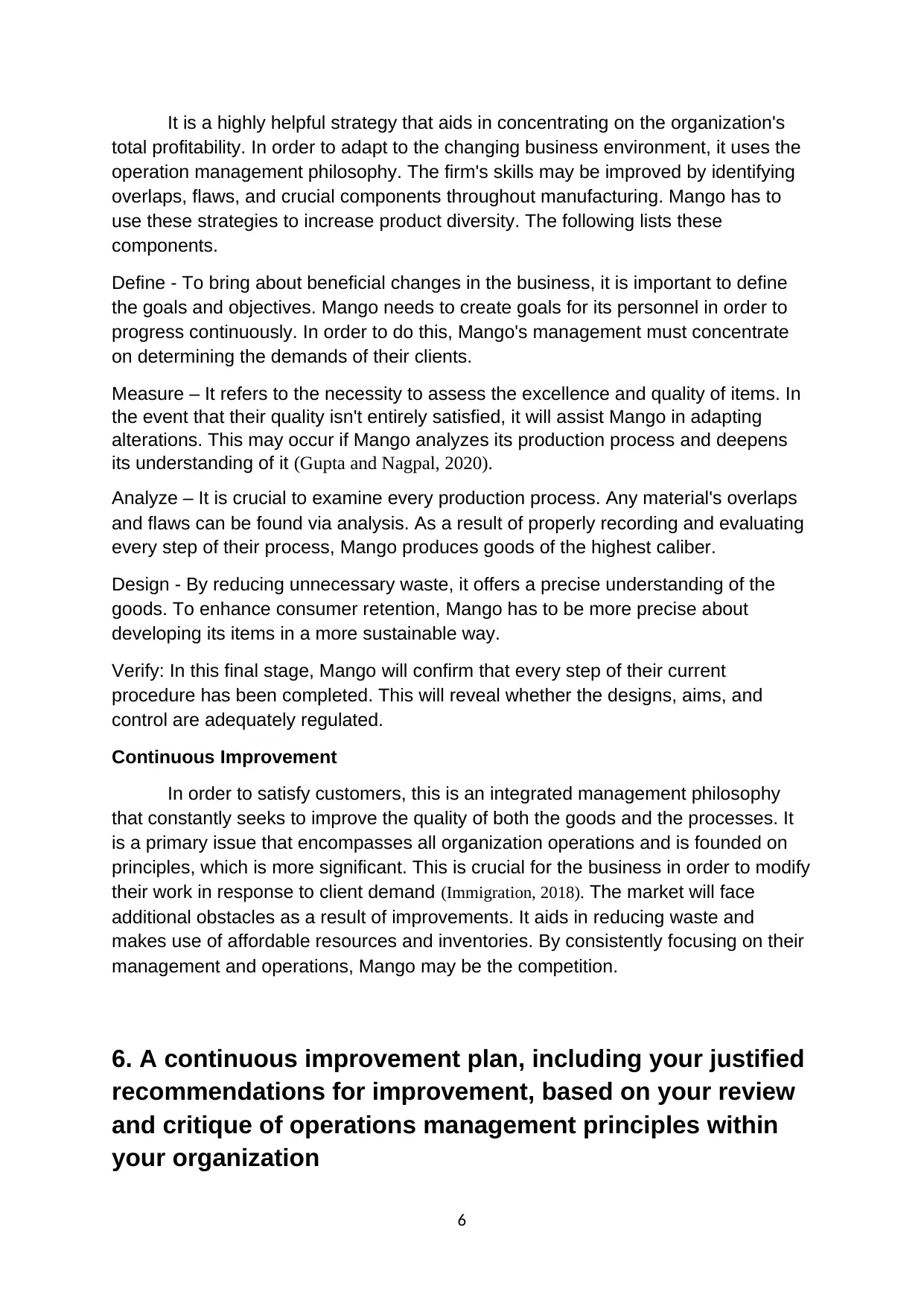
It is a highly helpful strategy that aids in concentrating on the organization's
total profitability. In order to adapt to the changing business environment, it uses the
operation management philosophy. The firm's skills may be improved by identifying
overlaps, flaws, and crucial components throughout manufacturing. Mango has to
use these strategies to increase product diversity. The following lists these
components.
Define - To bring about beneficial changes in the business, it is important to define
the goals and objectives. Mango needs to create goals for its personnel in order to
progress continuously. In order to do this, Mango's management must concentrate
on determining the demands of their clients.
Measure – It refers to the necessity to assess the excellence and quality of items. In
the event that their quality isn't entirely satisfied, it will assist Mango in adapting
alterations. This may occur if Mango analyzes its production process and deepens
its understanding of it (Gupta and Nagpal, 2020).
Analyze – It is crucial to examine every production process. Any material's overlaps
and flaws can be found via analysis. As a result of properly recording and evaluating
every step of their process, Mango produces goods of the highest caliber.
Design - By reducing unnecessary waste, it offers a precise understanding of the
goods. To enhance consumer retention, Mango has to be more precise about
developing its items in a more sustainable way.
Verify: In this final stage, Mango will confirm that every step of their current
procedure has been completed. This will reveal whether the designs, aims, and
control are adequately regulated.
Continuous Improvement
In order to satisfy customers, this is an integrated management philosophy
that constantly seeks to improve the quality of both the goods and the processes. It
is a primary issue that encompasses all organization operations and is founded on
principles, which is more significant. This is crucial for the business in order to modify
their work in response to client demand (Immigration, 2018). The market will face
additional obstacles as a result of improvements. It aids in reducing waste and
makes use of affordable resources and inventories. By consistently focusing on their
management and operations, Mango may be the competition.
6. A continuous improvement plan, including your justified
recommendations for improvement, based on your review
and critique of operations management principles within
your organization
6
total profitability. In order to adapt to the changing business environment, it uses the
operation management philosophy. The firm's skills may be improved by identifying
overlaps, flaws, and crucial components throughout manufacturing. Mango has to
use these strategies to increase product diversity. The following lists these
components.
Define - To bring about beneficial changes in the business, it is important to define
the goals and objectives. Mango needs to create goals for its personnel in order to
progress continuously. In order to do this, Mango's management must concentrate
on determining the demands of their clients.
Measure – It refers to the necessity to assess the excellence and quality of items. In
the event that their quality isn't entirely satisfied, it will assist Mango in adapting
alterations. This may occur if Mango analyzes its production process and deepens
its understanding of it (Gupta and Nagpal, 2020).
Analyze – It is crucial to examine every production process. Any material's overlaps
and flaws can be found via analysis. As a result of properly recording and evaluating
every step of their process, Mango produces goods of the highest caliber.
Design - By reducing unnecessary waste, it offers a precise understanding of the
goods. To enhance consumer retention, Mango has to be more precise about
developing its items in a more sustainable way.
Verify: In this final stage, Mango will confirm that every step of their current
procedure has been completed. This will reveal whether the designs, aims, and
control are adequately regulated.
Continuous Improvement
In order to satisfy customers, this is an integrated management philosophy
that constantly seeks to improve the quality of both the goods and the processes. It
is a primary issue that encompasses all organization operations and is founded on
principles, which is more significant. This is crucial for the business in order to modify
their work in response to client demand (Immigration, 2018). The market will face
additional obstacles as a result of improvements. It aids in reducing waste and
makes use of affordable resources and inventories. By consistently focusing on their
management and operations, Mango may be the competition.
6. A continuous improvement plan, including your justified
recommendations for improvement, based on your review
and critique of operations management principles within
your organization
6
Paraphrase This Document
Need a fresh take? Get an instant paraphrase of this document with our AI Paraphraser
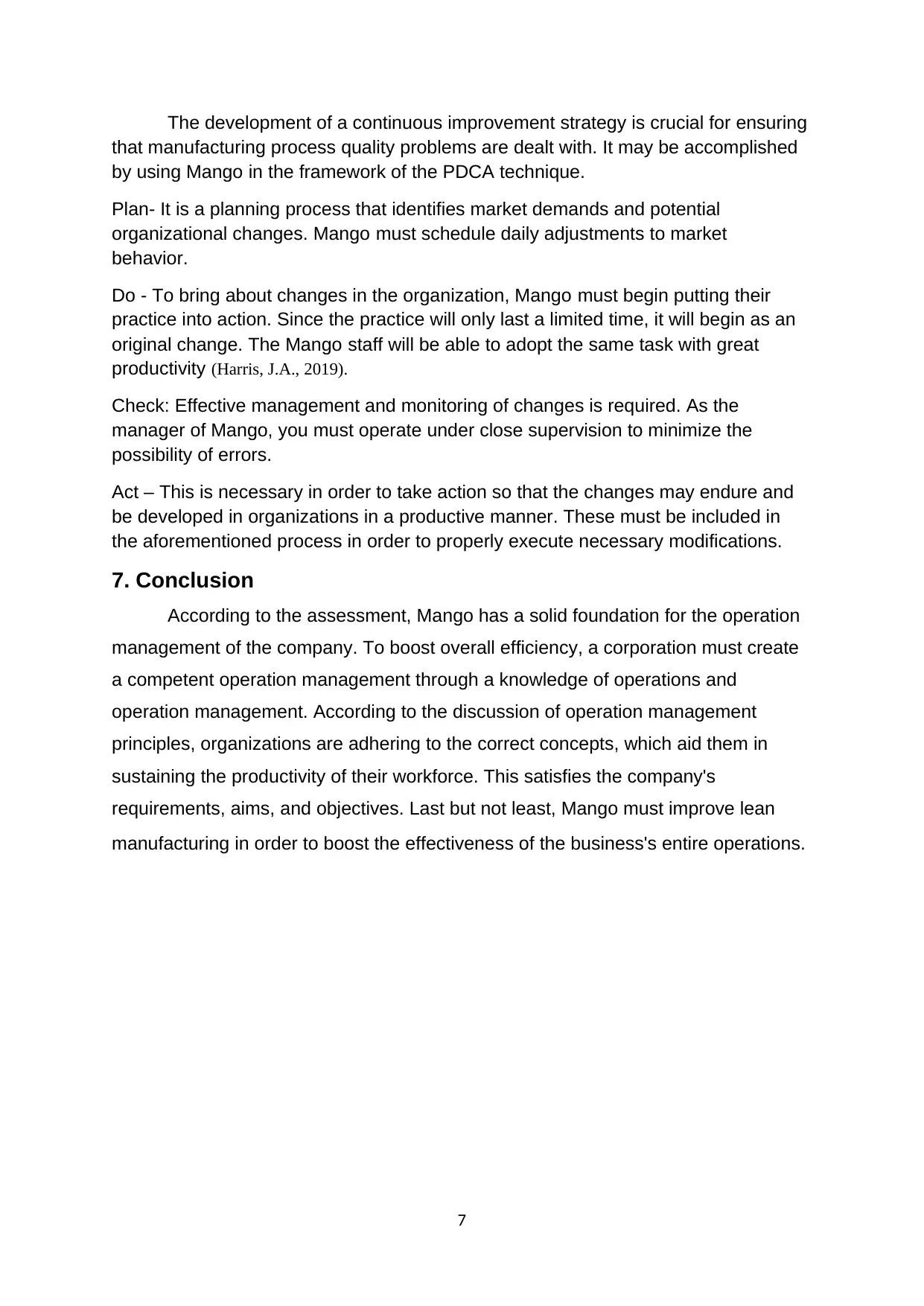
The development of a continuous improvement strategy is crucial for ensuring
that manufacturing process quality problems are dealt with. It may be accomplished
by using Mango in the framework of the PDCA technique.
Plan- It is a planning process that identifies market demands and potential
organizational changes. Mango must schedule daily adjustments to market
behavior.
Do - To bring about changes in the organization, Mango must begin putting their
practice into action. Since the practice will only last a limited time, it will begin as an
original change. The Mango staff will be able to adopt the same task with great
productivity (Harris, J.A., 2019).
Check: Effective management and monitoring of changes is required. As the
manager of Mango, you must operate under close supervision to minimize the
possibility of errors.
Act – This is necessary in order to take action so that the changes may endure and
be developed in organizations in a productive manner. These must be included in
the aforementioned process in order to properly execute necessary modifications.
7. Conclusion
According to the assessment, Mango has a solid foundation for the operation
management of the company. To boost overall efficiency, a corporation must create
a competent operation management through a knowledge of operations and
operation management. According to the discussion of operation management
principles, organizations are adhering to the correct concepts, which aid them in
sustaining the productivity of their workforce. This satisfies the company's
requirements, aims, and objectives. Last but not least, Mango must improve lean
manufacturing in order to boost the effectiveness of the business's entire operations.
7
that manufacturing process quality problems are dealt with. It may be accomplished
by using Mango in the framework of the PDCA technique.
Plan- It is a planning process that identifies market demands and potential
organizational changes. Mango must schedule daily adjustments to market
behavior.
Do - To bring about changes in the organization, Mango must begin putting their
practice into action. Since the practice will only last a limited time, it will begin as an
original change. The Mango staff will be able to adopt the same task with great
productivity (Harris, J.A., 2019).
Check: Effective management and monitoring of changes is required. As the
manager of Mango, you must operate under close supervision to minimize the
possibility of errors.
Act – This is necessary in order to take action so that the changes may endure and
be developed in organizations in a productive manner. These must be included in
the aforementioned process in order to properly execute necessary modifications.
7. Conclusion
According to the assessment, Mango has a solid foundation for the operation
management of the company. To boost overall efficiency, a corporation must create
a competent operation management through a knowledge of operations and
operation management. According to the discussion of operation management
principles, organizations are adhering to the correct concepts, which aid them in
sustaining the productivity of their workforce. This satisfies the company's
requirements, aims, and objectives. Last but not least, Mango must improve lean
manufacturing in order to boost the effectiveness of the business's entire operations.
7

References
Azadegan, A., Modi, S. and Lucianetti, L., 2021. Surprising supply chain disruptions:
Mitigation effects of operational slack and supply redundancy. International Journal
of Production Economics. 240. p.108218.
Chen, C.H.V. and Chen, Y.C., 2021. Influence of intellectual capital and integration on
operational performance: big data analytical capability perspectives. Chinese
Management Studies.
de Villiers Getz, L., 2020. Connecting Senior Managers and Certification Regime
requirements with operational risk. Journal of Securities Operations &
Custody. 12(3). Pp .207-218.
Gupta, G. and Nagpal, S., 2020. Green dimensions, environment orientation and size: impact
assessment on operational performance of manufacturing firms. Global Business
Review, p.0972150920919880.
Harris, J.A., 2019. The Difficult Plantation Past: Operational and Leadership Mechanisms
and Their Impact on Racialized Narratives at Tourist Plantations (Doctoral
dissertation, Middle Tennessee State University).
Immigration, R., 2018. Immigration Operational Bulletin 659–October 29, 2018.
Jackson, E.L. and Adamson, D., 2018. The live sheep export supply chain: When operational
and societal complexities collide. International Journal of Business and Systems
Research. 12(2). pp.181-196.
Kuruppuge, R.H. and Gregar, A., 2020. Strategic, tactical and operational decisions in family
businesses: a qualitative case study. The Qualitative Report. 25(6). pp.1599-1618.
Meng, M. and Pang, T., 2022. Operational efficiency analysis of China's electric power
industry using a dynamic network slack-based measure model. Energy. 251.
p.123898.
Mitic, P., 2022. Correlations in Operational Risk Stress Testing: Use and Abuse. Journal of
Operational Risk. 17(2).
Nikouei, A. and Mardani, M., 2021. Application of Agricultural Land Cadastre in
Compilation of Comprehensive and Operational Cropping Pattern of Farms: A Case
Study in Isfahan Province. Agricultural Economics and Development. 29(1). pp.235-
266.
Thapa, R.J., 2019. Challenges faced by the hospital industry in Nepal: guidelines to enhance
operational efficiency and effectiveness in primary value chains (Doctoral
dissertation, University of the West of Scotland).
Vijaya Sunder M and Ganesh, L.S., 2020. Lean Six Sigma in Banking Services: Operational
and Strategy Applications for Theory and Practice. Springer Singapore.
8
Azadegan, A., Modi, S. and Lucianetti, L., 2021. Surprising supply chain disruptions:
Mitigation effects of operational slack and supply redundancy. International Journal
of Production Economics. 240. p.108218.
Chen, C.H.V. and Chen, Y.C., 2021. Influence of intellectual capital and integration on
operational performance: big data analytical capability perspectives. Chinese
Management Studies.
de Villiers Getz, L., 2020. Connecting Senior Managers and Certification Regime
requirements with operational risk. Journal of Securities Operations &
Custody. 12(3). Pp .207-218.
Gupta, G. and Nagpal, S., 2020. Green dimensions, environment orientation and size: impact
assessment on operational performance of manufacturing firms. Global Business
Review, p.0972150920919880.
Harris, J.A., 2019. The Difficult Plantation Past: Operational and Leadership Mechanisms
and Their Impact on Racialized Narratives at Tourist Plantations (Doctoral
dissertation, Middle Tennessee State University).
Immigration, R., 2018. Immigration Operational Bulletin 659–October 29, 2018.
Jackson, E.L. and Adamson, D., 2018. The live sheep export supply chain: When operational
and societal complexities collide. International Journal of Business and Systems
Research. 12(2). pp.181-196.
Kuruppuge, R.H. and Gregar, A., 2020. Strategic, tactical and operational decisions in family
businesses: a qualitative case study. The Qualitative Report. 25(6). pp.1599-1618.
Meng, M. and Pang, T., 2022. Operational efficiency analysis of China's electric power
industry using a dynamic network slack-based measure model. Energy. 251.
p.123898.
Mitic, P., 2022. Correlations in Operational Risk Stress Testing: Use and Abuse. Journal of
Operational Risk. 17(2).
Nikouei, A. and Mardani, M., 2021. Application of Agricultural Land Cadastre in
Compilation of Comprehensive and Operational Cropping Pattern of Farms: A Case
Study in Isfahan Province. Agricultural Economics and Development. 29(1). pp.235-
266.
Thapa, R.J., 2019. Challenges faced by the hospital industry in Nepal: guidelines to enhance
operational efficiency and effectiveness in primary value chains (Doctoral
dissertation, University of the West of Scotland).
Vijaya Sunder M and Ganesh, L.S., 2020. Lean Six Sigma in Banking Services: Operational
and Strategy Applications for Theory and Practice. Springer Singapore.
8
⊘ This is a preview!⊘
Do you want full access?
Subscribe today to unlock all pages.

Trusted by 1+ million students worldwide

PROJECT
MANANGEMENT
9
MANANGEMENT
9
Paraphrase This Document
Need a fresh take? Get an instant paraphrase of this document with our AI Paraphraser
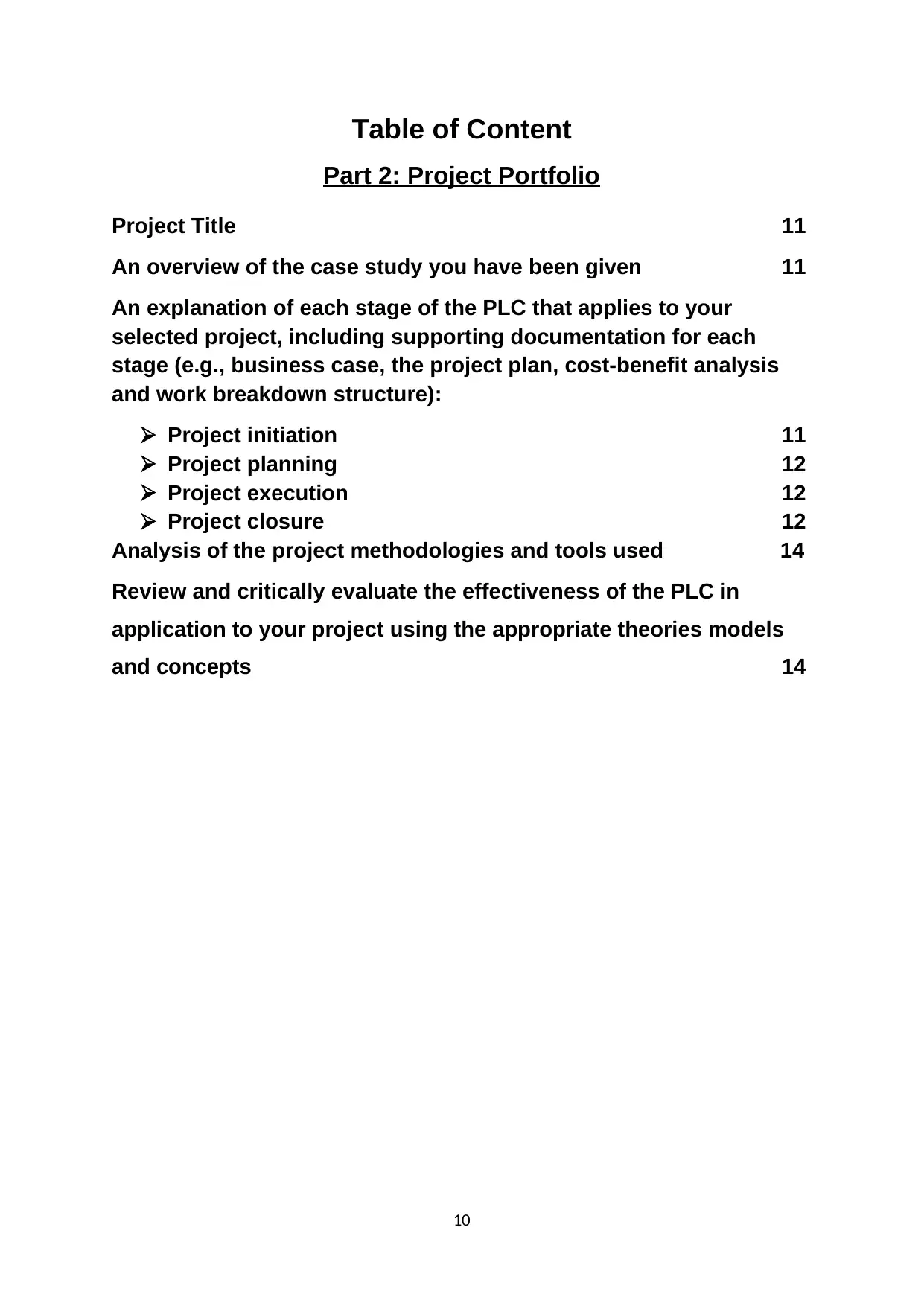
Table of Content
Part 2: Project Portfolio
Project Title 11
An overview of the case study you have been given 11
An explanation of each stage of the PLC that applies to your
selected project, including supporting documentation for each
stage (e.g., business case, the project plan, cost-benefit analysis
and work breakdown structure):
Project initiation 11
Project planning 12
Project execution 12
Project closure 12
Analysis of the project methodologies and tools used 14
Review and critically evaluate the effectiveness of the PLC in
application to your project using the appropriate theories models
and concepts 14
10
Part 2: Project Portfolio
Project Title 11
An overview of the case study you have been given 11
An explanation of each stage of the PLC that applies to your
selected project, including supporting documentation for each
stage (e.g., business case, the project plan, cost-benefit analysis
and work breakdown structure):
Project initiation 11
Project planning 12
Project execution 12
Project closure 12
Analysis of the project methodologies and tools used 14
Review and critically evaluate the effectiveness of the PLC in
application to your project using the appropriate theories models
and concepts 14
10

Project Title
Project Management defines as the best utilization of skills, techniques, tools,
specific knowledge for delivering something valuable to people. In other words,
project management refers to the process in which a particular time frame is fixed to
hit goals with the help of a team. The objectives of project management are to
effectively complete work within the limitations of time, scope, and money. Project
management includes project documentation, planning, tracking, and communication
(Kshirsagar, 2020). In order to implement a project to lower employee absenteeism,
this report will discuss case study-related methodologies and project life cycle
phases. This may be accomplished by creating a business case and applying the
project life cycle correctly. The major goals of this initiative are to provide on-site
catering, support staff members' healthy lifestyles, and lower absenteeism.
An overview of the case study you have been given
The case study here represents the stages involved in delivering the project in
the correct procedure. Projects are the main goals of an organization which is
necessarily to be achieved in a particular time frame. Each project or goal comes
with its expected deadline. Therefore, it is the necessity for a project to regulate its
processes with the help of proper planning, initiation and execution. BSS Industrial is
a distributor of building material that employs approx. 1903 employees. The
company has set its own objectives to lower employee absenteeism brought on by
snacking and casually roaming. This has an impact on both the industry's success
and the company's reputation (Awe and Church, 2020).The company has to use
certain tactics to get its workers more involved in extracurricular activities that would
improve their performance. This may be accomplished by emphasizing CSR and
providing lunch options for employees. This becomes crucial in order to give
employees a healthy diet and way of life that will improve their productivity.
An explanation of each stage of the PLC that applies to
your selected project, including supporting documentation
for each stage (e.g., business case, the project plan, cost-
benefit analysis and work breakdown structure):
Project life cycle refers to the array of phases in which a project will move
forward. This comes with the management of the particular project by the project
manager for attaining the goals from beginning to end. In reference to BSS Industrial
Services, the phases of PLC are given below:
Project initiation
This is a starting phase of the project life cycle in which companies observed new ideas,
techniques and insights in order to achieve respective objectives. BSS Industrial services
needs to analyse its requirements and resources and after taking everything into
consideration then, initiate a plan which helps in attaining the success of the firm in a
11
Project Management defines as the best utilization of skills, techniques, tools,
specific knowledge for delivering something valuable to people. In other words,
project management refers to the process in which a particular time frame is fixed to
hit goals with the help of a team. The objectives of project management are to
effectively complete work within the limitations of time, scope, and money. Project
management includes project documentation, planning, tracking, and communication
(Kshirsagar, 2020). In order to implement a project to lower employee absenteeism,
this report will discuss case study-related methodologies and project life cycle
phases. This may be accomplished by creating a business case and applying the
project life cycle correctly. The major goals of this initiative are to provide on-site
catering, support staff members' healthy lifestyles, and lower absenteeism.
An overview of the case study you have been given
The case study here represents the stages involved in delivering the project in
the correct procedure. Projects are the main goals of an organization which is
necessarily to be achieved in a particular time frame. Each project or goal comes
with its expected deadline. Therefore, it is the necessity for a project to regulate its
processes with the help of proper planning, initiation and execution. BSS Industrial is
a distributor of building material that employs approx. 1903 employees. The
company has set its own objectives to lower employee absenteeism brought on by
snacking and casually roaming. This has an impact on both the industry's success
and the company's reputation (Awe and Church, 2020).The company has to use
certain tactics to get its workers more involved in extracurricular activities that would
improve their performance. This may be accomplished by emphasizing CSR and
providing lunch options for employees. This becomes crucial in order to give
employees a healthy diet and way of life that will improve their productivity.
An explanation of each stage of the PLC that applies to
your selected project, including supporting documentation
for each stage (e.g., business case, the project plan, cost-
benefit analysis and work breakdown structure):
Project life cycle refers to the array of phases in which a project will move
forward. This comes with the management of the particular project by the project
manager for attaining the goals from beginning to end. In reference to BSS Industrial
Services, the phases of PLC are given below:
Project initiation
This is a starting phase of the project life cycle in which companies observed new ideas,
techniques and insights in order to achieve respective objectives. BSS Industrial services
needs to analyse its requirements and resources and after taking everything into
consideration then, initiate a plan which helps in attaining the success of the firm in a
11
⊘ This is a preview!⊘
Do you want full access?
Subscribe today to unlock all pages.

Trusted by 1+ million students worldwide
1 out of 17
Related Documents
Your All-in-One AI-Powered Toolkit for Academic Success.
+13062052269
info@desklib.com
Available 24*7 on WhatsApp / Email
![[object Object]](/_next/static/media/star-bottom.7253800d.svg)
Unlock your academic potential
Copyright © 2020–2025 A2Z Services. All Rights Reserved. Developed and managed by ZUCOL.




